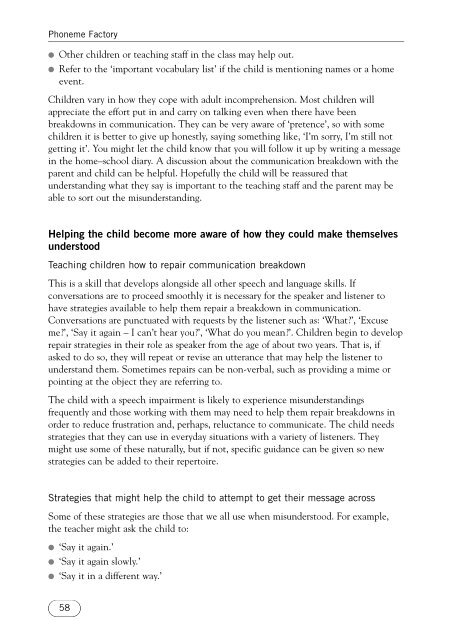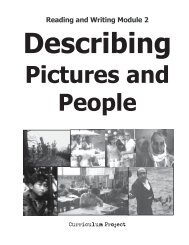Developing Speech and Language Skills - Noel's ESL eBook Library
Developing Speech and Language Skills - Noel's ESL eBook Library
Developing Speech and Language Skills - Noel's ESL eBook Library
Create successful ePaper yourself
Turn your PDF publications into a flip-book with our unique Google optimized e-Paper software.
Phoneme Factory● Other children or teaching staff in the class may help out.● Refer to the ‘important vocabulary list’ if the child is mentioning names or a homeevent.Children vary in how they cope with adult incomprehension. Most children willappreciate the effort put in <strong>and</strong> carry on talking even when there have beenbreakdowns in communication. They can be very aware of ‘pretence’, so with somechildren it is better to give up honestly, saying something like, ‘I’m sorry, I’m still notgetting it’. You might let the child know that you will follow it up by writing a messagein the home–school diary. A discussion about the communication breakdown with theparent <strong>and</strong> child can be helpful. Hopefully the child will be reassured thatunderst<strong>and</strong>ing what they say is important to the teaching staff <strong>and</strong> the parent may beable to sort out the misunderst<strong>and</strong>ing.Helping the child become more aware of how they could make themselvesunderstoodTeaching children how to repair communication breakdownThis is a skill that develops alongside all other speech <strong>and</strong> language skills. Ifconversations are to proceed smoothly it is necessary for the speaker <strong>and</strong> listener tohave strategies available to help them repair a breakdown in communication.Conversations are punctuated with requests by the listener such as: ‘What?’, ‘Excuseme?’, ‘Say it again – I can’t hear you?’, ‘What do you mean?’. Children begin to developrepair strategies in their role as speaker from the age of about two years. That is, ifasked to do so, they will repeat or revise an utterance that may help the listener tounderst<strong>and</strong> them. Sometimes repairs can be non-verbal, such as providing a mime orpointing at the object they are referring to.The child with a speech impairment is likely to experience misunderst<strong>and</strong>ingsfrequently <strong>and</strong> those working with them may need to help them repair breakdowns inorder to reduce frustration <strong>and</strong>, perhaps, reluctance to communicate. The child needsstrategies that they can use in everyday situations with a variety of listeners. Theymight use some of these naturally, but if not, specific guidance can be given so newstrategies can be added to their repertoire.Strategies that might help the child to attempt to get their message acrossSome of these strategies are those that we all use when misunderstood. For example,the teacher might ask the child to:● ‘Say it again.’● ‘Say it again slowly.’● ‘Say it in a different way.’58











